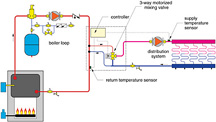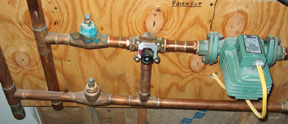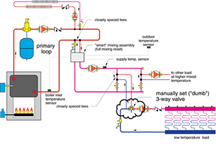
I like to think of the mixing controls and piping around them as a “mixing assembly” that forms a bridge between the higher temperature boiler circuit and lower temperature distribution circuit as shown in Figure 1. All heat that makes it from the boiler to the distribution circuit has to cross this bridge. With proper control, the “Btu traffic” across the bridge can range from zero to full design load rate.
When the heat is supplied by a conventional boiler, the mixing assembly must do two things:
- 1. Accurately control the supply water temperature to the distribution system.
2. Prevent the boiler from operating with sustained flue gas condensation.

Another example of a smart mixing assembly would be a single three-way motorized valve as shown in Figure 3. The controller that operates the valve actuator senses both supply temperature to the distribution system and inlet temperature to the boiler. If the latter is low enough to cause flue gas condensation, the controller reacts by slowly closing the hot port of the mixing valve until the boiler temperature rises to the point where flue gas condensation is not occurring. A four-way motorized mixing valve with the same type of controller could provide the same type of control. So could a variable-speed injection pump.

Dumbed Down
In the interest of saving money, more than a few people have questioned the need to install the “brains” of a motorized three-way or four-way mixing assembly. Their incorrect reasoning goes something like this: If I install the three-way or four-way valve body and set its handle so the temperature to the distribution system is about right, the supply temperature will stay at that temperature whenever the system operates.Although such a strategy might provide tolerable performance with low-mass heat sources and distribution systems, it's not going to work for higher-mass systems such as cast-iron boilers supplying heated concrete slabs.
The problem is that a three-way or four-way rotary valve without a controller is totally blind to what's happening as a result of the mixing. If the hot water temperature supplied by the boiler and the temperature returning from the distribution system were both rock steady, then (and only then) would the mix temperature from the valve remain constant.
Unfortunately, heating systems very seldom experience such operating conditions. Theirs is the world of incessant transients, where water temperature from the heat source, as well as the distribution system, is usually fluctuating. This happens because of the differential associated with burner operation, the lag in bringing a high-thermal-mass heat emitter up to normal operating temperatures, zone circuits turning on and off, and reaction to internal heat gains.
A mixing valve without brains will not provide acceptable performance under these very typical operating conditions. Installing such a valve without the associated controller is like buying a high-quality car, starting the engine, shifting it into gear, and expecting it to drive itself from that point on.
Some of you are probably thinking that this should all be too obvious to anyone who installs hydronic systems. Several mechanical rooms that I've visited or viewed photos of indicate otherwise (see Figures 4 and 5 for some examples).

Three-way or four-way mixing valves without controllers can produce large temperature variations in both the distribution system and the boiler. The results can be corroded boilers and vent connectors, very slow recovery from temperature setbacks, and excessively hot temperatures supplied to low-temperature heat emitters. Call-backs are sure to follow this type of installation, and the cost of properly configuring the mixing valves will only be higher than doing the job right in the first place.

When It's OK Not To Have A Brain
There are applications where manually set (“dumb”) mixing valves can be used successfully. When installed “downstream” of a smart mixing assembly or a boiler operated on an outdoor reset control, the temperature of the hot water entering the manually set mixing valve varies in response to the load conditions (e.g., outdoor reset control).This, in combination with the changing load and changing temperature drop of the distribution system, allows the mixing valve to produce an outlet temperature that “tracks” the change in entering hot water temperature. This concept is called proportional reset, as illustrated in Figure 6. Note that the mixed outlet temperature from the dumb valve is always lower than the mixed temperature from the smart mixing assembly.
To picture why this happens, think about standing in a shower that has two manually set valves - one for hot water and the other for cold. Imagine that you've set the blended temperature coming out of the showerhead to your liking. After a few minutes in the shower, the temperature of the water supplied to the hot water faucet begins decreasing. The blended temperature coming from the shower also decreases.
Your (smart) response to this situation is to increase the flow rate of hot water, decrease the flow of cool water, or both in an attempt to keep the blended temperature reasonably comfortable. However, in a heating system, the predicable drop in mixed supply water temperature as the load decreases is often desirable. Hence, the manually set mixing valve could maintain the same flow proportions and still produce a desired effect.

A manually set mixing device cannot react to protect a conventional boiler from low-temperature operation. When such a device supplies a low-temperature/high-thermal-mass distribution system that represents more than 25 percent of the boiler's total heating output, it should only be used downstream of an intelligent mixing device that can protect the boiler.
The use of manually set mixing valves is not a good idea in systems where there will be frequent changes in thermostat settings. This is especially true when heat is delivered through high-mass radiant panels. Such a system would experience long recovery times following a setback because the mixed temperature supplied to the circuits would be depressed by the cooler-than-normal temperature returning from the radiant panel circuit. An intelligent mixing assembly could compensate for this. A dumb mixing assembly cannot.
Both smart and dumb mixing valves have their place. Smart system designers always determine how much intelligence the mixing valves in their systems require, and ensure they are properly configured.

